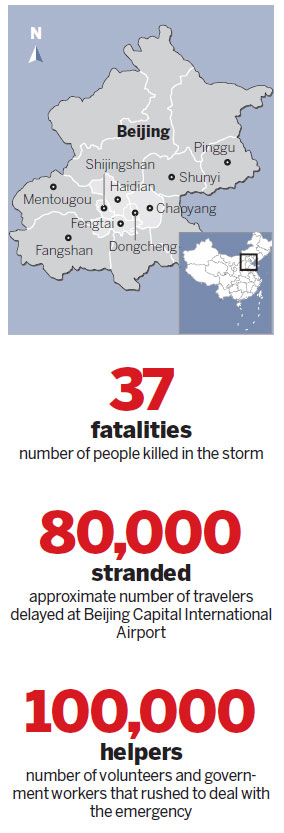Death and destruction in 20 hours
Updated: 2012-07-23 07:44
By He Na and Cao Yin (China Daily)
|
|||||||||||
The heavy rains that lashed Beijing on the weekend caused chaos for the capital's transportation systems and paralyzed a huge number of low-lying areas, mostly those with poor drainage facilities. The storm clouds rolled in at around midday on Saturday and lasted more than 20 hours, resulting in the most devastating downpour in the Chinese capital for 61 years.
Data from Beijing Meteorological Bureau show that urban areas in the municipality were inundated by 170 millimeters of precipitation during the deluge. In the hardest-hit area, Hebei town in the southwestern district of Fangshan, the rainfall reached 460 mm. The destructive force of the storm left 37 people dead, injured many others and caused widespread damage to buildings, infrastructure and crops. In the 12 worst-hit counties in Fangshan district, power, water and communications systems were widely disrupted, according to the Beijing emergency management office.
 |
|
Rescuers evacuate pupils on Sunday, after they were trapped by heavy rain, from a military training center in the Fangshan district of Beijing. [Photo/Xinhua] |
Ground transportation
|
||||
Photos uploaded to micro blogs showed people swimming in the deep water that clogged the roads. Some people joked that the rain had turned the capital into a huge swimming pool.
"It sounded as if the sky had cracked. The water on the ground was just like an ocean wave, driven forward by the strong winds," said Zheng Lili, who was stranded at Beijing Railway Station during the downpour.
On major thoroughfares, including the 2nd to 4th ring roads, many overpasses were waterlogged. A 34-year-old man drowned when he was unable to break free from his car, which was stranded in deep water under Guangqumen Bridge on the East 2nd Ring Road. Hundreds of motorists abandoned their broken-down vehicles.
Waterlogged communities
Wangchunyuan community is located close to Lishui Bridge in Beijing's Chaoyang district. It resembled a lake on Saturday but was slowly returning to normal as the waters receded on Sunday morning.
"The water came up to my waist," said Zheng Fengxuan, as he attempted to clean his car after it had spent a day submerged. "The drainage system around the community has had some problems recently. We reported them, but nothing was done to rectify them."
Zhu Ning, who also lives in the community, was not as lucky as Zheng whose car still worked despite its soaking on Saturday. "My car's engine doesn't work anymore," said Zhu. "The water came as high as the headlights on Saturday evening," she said, before shouting to her husband to call the insurance company.
"Our community was like a large pond last night. The water was about a meter deep, lapping at the sides of the cars in the parking lots," said Wei Xiaobo, one of the security guards for the community.
The ground around the community's north gate is lower-lying than most of the surrounding area, and so the water converged there. There was so much water that the drainage systems simply couldn't cope, he said.
Another resident, Li Ming, 29, pointed to a white flatbed truck, used for recycling. He said a sofa on back of the truck was washed away by the force of the water and that one of the residents, a foreigner, had taken to the waters to swim to a local supermarket to buy food for dinner.
"At midnight, the rain began to ease off and some emergency vehicles arrived," said Li, who added that members of the emergency services were forced to crack a hole in a sewer pipe, about 30 meters from the community's north gate, to speed up the rate of drainage.
Subway
The storm paralyzed almost all ground transport. Many roads below overpasses lay under water up to a meter deep, leaving many motorists stranded.
The water also leaked into the subway at some points. Services were suspended at a number of stations because of minor flooding. Generally, however, the system operated normally.
In Chaoyang district, the heavy downpour caused the collapse of a construction site on subway Line 6. Dozens of workers raced to the scene to carry out repairs, preventing major damage to the system.
Suburban rescue
Some 30,000 people stranded in mountainous regions on the outskirts of the capital were rescued and transferred to safe areas. Across the city, more than 100,000 volunteers and government workers rushed to deal with the emergency, according to the Beijing flood control and drought relief headquarters.
The heavy rain also triggered landslides in some mountainous areas.
Li Fanghong, a police station director, was killed as he helped residents of one of the worst-hit areas, Fenghuangting village. Li accidentally touched a live electric cable as he and his colleagues fought to rescue more than 50 people trapped by the rising waters.
The deluge also triggered mountain torrents in Fangshan district, cutting off some 400 people, students and teachers at a military training site. Because the roads were impassable, soldiers made their way to the spot on foot and, aided by the emergency services, rescued all the students and teachers without injury.
Today's Top News
President Xi confident in recovery from quake
H7N9 update: 104 cases, 21 deaths
Telecom workers restore links
Coal mine blast kills 18 in Jilin
Intl scholarship puts China on the map
More bird flu patients discharged
Gold loses sheen, but still a safe bet
US 'turns blind eye to human rights'
Hot Topics
Lunar probe , China growth forecasts, Emission rules get tougher, China seen through 'colored lens', International board,
Editor's Picks

|

|

|

|

|

|








